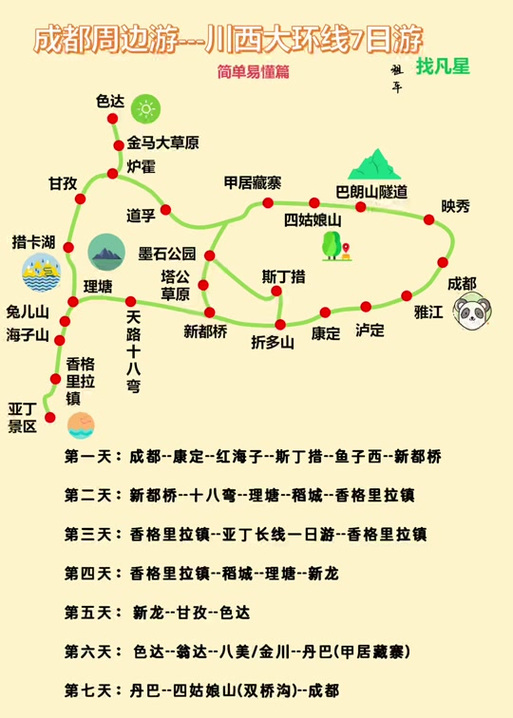核心亮点:为什么选择这条路?
- 景观的极致变化:从成都平原的繁华安逸,到雅安“雨城”的湿润,再到二郎山隧道的穿越,最后抵达“光与影的世界”新都桥,沿途风景层次感极强,被誉为“从盆地走向高原的景观长廊”。
- “摄影家天堂”:新都桥本身没有标志性的景点,但其沿线10公里(国道318川藏南线)的田园风光、藏式民居、白杨树、溪流、雪山、云海,构成了无数摄影爱好者梦寐以求的画面。
- 康巴文化体验:途径康定情歌的故乡,可以感受浓郁的康巴藏族风情。
- 自驾的乐趣:路况良好,风景多样,是体验川藏线精华前段的绝佳选择。
路线详解
经典路线(推荐)
- 全程:约330公里
- 耗时:正常驾驶约6-7小时,但游玩拍照会延长至1-2天。
- 路况:全程柏油/水泥路面,非常好走,雅康高速(G4218)和雅叶高速(G4218)的开通,大大缩短了时间,但老国道318线沿途风景更佳,可以两条路结合走。
详细分段:

(图片来源网络,侵删)
第1段:成都 → 雅安 (约140公里,2小时车程)
- 路线:成都市区 → 京昆高速(G5) 或 成雅高速 → 雅安。
- 特色:出城后很快进入平原与丘陵过渡带,道路两旁绿树成荫,雅安是“雨城”,也是“三雅文化”(雅雨、雅女、雅鱼)的发源地,可以在此午餐,品尝正宗的雅鱼。
- 必停点:
- 碧峰峡:如果时间充裕,可以顺路游览碧峰峡风景区,看大熊猫,感受峡谷清幽。
- 周公河:在雅安市区可以品尝雅鱼。
第2段:雅安 → 泸定 (约80公里,1.5小时车程)
- 路线:雅安 → 雅康高速(G4218) 或 国道318线 → 泸定。
- 特色:这是进入高原前的关键一段,高速隧道群(尤其是二郎山隧道)非常壮观,翻越二郎山后,地貌豁然开朗,青衣江峡谷风光尽收眼底。
- 必停点:
- 二郎山隧道:穿越世界级的长大隧道群,感受现代工程的奇迹。
- 大渡河峡谷:从高速上可以远眺,非常雄伟。
- 泸定桥:就在泸定县城,是红色旅游经典景点,如果对历史感兴趣,值得一看,桥下就是奔腾的大渡河。
第3段:泸定 → 康定 (约50公里,1小时车程)
- 路线:泸定 → 雅叶高速(G4218) 或 国道318线 → 康定。
- 特色:从海拔约1000米的泸定,迅速上升到海拔约2600米的康定,海拔急剧爬升,是身体适应高原的开始,沿途可以远眺蜀山之王——贡嘎雪山。
- 必停点:
- 康定情歌风景区(木格措):如果时间充裕且想玩水,可以走景区路去木格措,但会绕路,不适合当天直奔新都桥的游客。
- 康定情歌广场:在康定市区可以感受这座情歌城市的氛围,买些补给。
第4段:康定 → 新都桥 (约78公里,2小时车程)

(图片来源网络,侵删)
- 路线:康定 → 国道318线 → 新都桥镇。
- 特色:这是整个行程最精华、最令人期待的路段!翻越海拔4298米的折多山口,正式进入真正的藏区,山顶经幡飘扬,视野开阔,可以360度环顾雪山,下山后,便是新都桥的“摄影家天堂”风光。
- 必停点:
- 折多山观景台:必停! 这里是新都桥前的最后一个高山垭口,是拍摄贡嘎雪山和云海的最佳地点之一,注意保暖,山顶风大且气温低。
- 高尔寺山:虽然现在有隧道,但老路风景依然绝美。
- 新都桥摄影天堂:进入新都桥镇后,不要急着进城,沿着国道318线两侧的村庄(如东俄洛、贡嘎山观景台)慢慢开,随时停车,处处是景。
行程规划建议
方案A:经典2日游(最推荐)
- Day 1:成都 → 康定/新都桥
- 上午:成都出发,沿雅康高速一路向西。
- 中午:在雅安或泸定午餐,品尝当地特色。
- 下午:翻越二郎山,抵达康定,短暂停留适应海拔。
- 傍晚:继续前行,翻越折多山,抵达新都桥,入住酒店后,可以在镇子周边或国道318线沿途拍摄日落和星空。
- Day 2:新都桥深度游 → 返回成都
- 上午:早起拍摄新都桥的晨雾和日出,之后在“摄影天堂”沿线自由拍摄,探访藏式村落。
- 中午:在新都桥午餐。
- 下午:沿原路返回成都,可以选择不同的高速路线,感受不同风景,傍晚抵达成都。
方案B:休闲3日游
- Day 1:成都 → 康定
- 行程相对轻松,中午在雅安或天全午餐,下午抵达康定,入住酒店。
- 下午可以在康定城区逛逛,去跑马山(索道)或康定情歌广场,晚上品尝藏餐,让身体慢慢适应海拔。
- Day 2:康定 → 新都桥 → 塔公草原
- 上午:从康定出发,翻越折多山,抵达新都桥,拍摄上午的光影。
- 中午:在新都桥午餐。
- 下午:从新都桥继续前行约37公里,抵达塔公草原,在草原上远眺雅拉雪山,参观塔公寺,感受辽阔。
- 傍晚:可选择返回新都桥住宿,或直接在塔公镇住宿(条件较简陋)。
- Day 3:塔公/新都桥 → 康定 → 成都
- 上午:在草原或新都桥拍摄晨景。
- 中午:返回康定午餐。
- 下午:从康定沿雅叶高速或雅康高速返回成都。
住宿推荐
- 新都桥镇:住宿选择最多,从高端酒店到经济型客栈、藏式民居应有尽有,建议选择位于国道318线两侧的客栈,推开窗就是风景,方便拍摄日出日落。
- 康定市:作为交通枢纽,酒店选择丰富,条件较好,适合第一天或第二天晚上在此休整。
- 塔公镇:住宿条件相对简单,多为当地家庭经营的客栈,适合想深度体验藏区风情且不介意条件的游客。
美食推荐
- 川菜/雅安菜:出发前在成都或雅安可以吃到正宗的麻辣火锅、串串香、雅鱼等。
- 藏餐:进入康定后,可以品尝到地道的藏餐。
- 酥油茶:咸甜口味可选,是补充能量、御寒的好东西。
- 牦牛肉:可以做成手抓肉、牦牛肉干、汤锅等,味道鲜美。
- 糌粑:青稞炒面,是藏族的主食。
- 藏式包子:馅料是牦牛肉,风味独特。
- 牦牛酸奶:非常浓郁,值得一试。
实用攻略 & 注意事项
- 最佳旅行时间:
- 秋季(9-11月):绝对的最佳时间! 天气晴朗,色彩最丰富,新都桥的杨树林金黄,与远处的雪山、

(图片来源网络,侵删)




